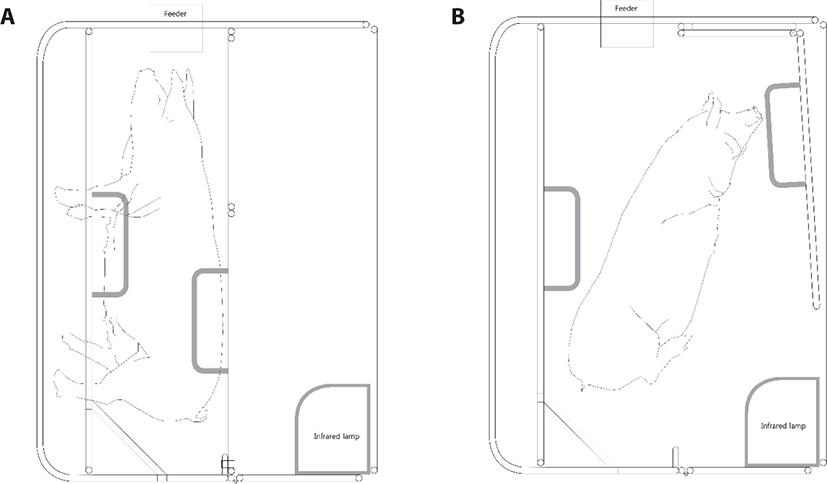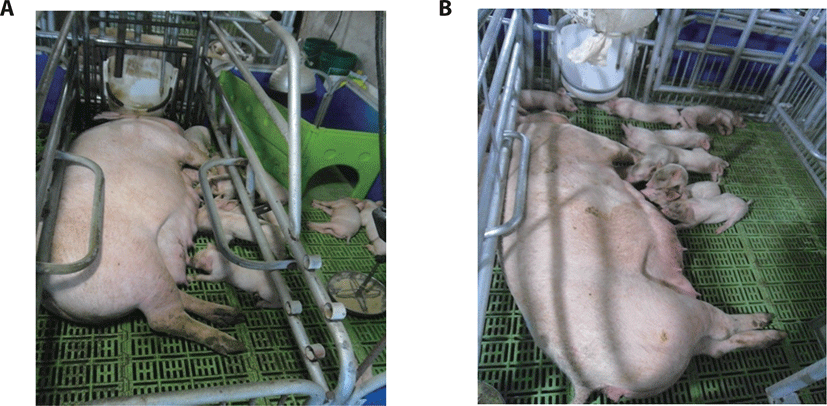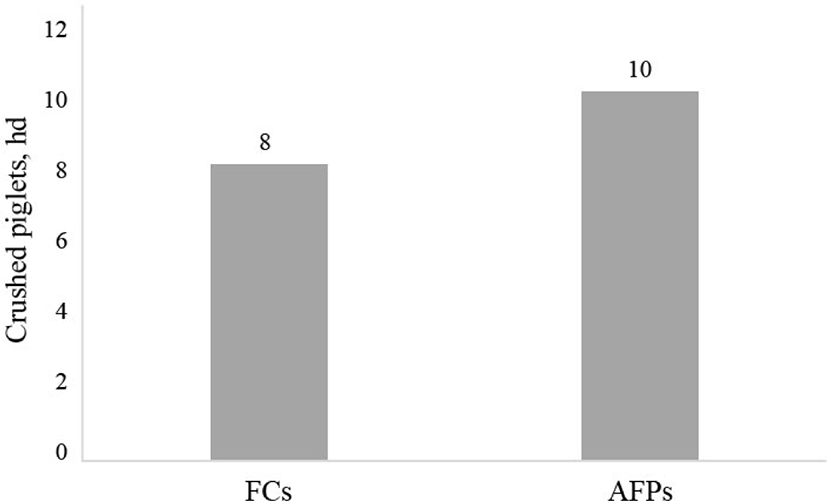INTRODUCTION
Farrowing crates (FCs) are widely used in the swine industry to reduce the number of crushed piglets during the lactation period. However, FCs raises serious welfare concerns that they restrict the sow’s physical movement and normal behavior, resulting in frustration and stress [1–4]. Recently, due to increasing public pressure to abolish FCs, loose farrowing systems (LFSs) have been introduced to improve sow and piglet welfare via different design features [5–7], compared to FCs such as reduced confinement and a greater amount of space. Sows in LFSs allow sows to turn around and interact more with their litters through providing more space. However, the important economic and welfare problem of pre-weaning piglet mortality in LFSs remains. Crushing is one of the major causes of pre-weaning piglet mortality, alongside starvation [8–12]. Piglets are most vulnerable until the first 4 days after birth, with more than 50%–80% of deaths occurring during this period [12–15]. Over the years, many researchers have endeavored to reduce the number of crushed piglets by sows by installing support devices, such as anti-crushing bars in LFSs [16,17]. Several studies have found no significant impact on piglet crushing mortality in LFSs because the sows lie down and roll over in the open area [18,19]. Attempts have been made to improve animal welfare for lactating sows and their litters, including circular, ellipsoid, rectangular, hinged crates and temporary crating systems. Nevertheless, these facilities are hard to install and manage in industrial swine farms.
Therefore, this study was performed to development the alternative farrowing pen (AFP) and to investigate the performance and behavior of lactating sows and their litter.
MATERIALS AND METHODS
The experiment was conducted on a commercial farm in Korea under mild weather (from October to November). A total of 64 multiparous sows (Yorkshire × Landrace) were randomly divided into two groups and were allocated to FCs and AFPs on day 7 prepartum from the expected farrowing day. All sows were familiar with FCs. On day 5 postpartum, the crates were opened to provide the sows with extra space in AFPs. All sows were fed a standard ration of commercial concentrate twice a day at 0700 and 1600 h (Table 1) and had ad libitum access to water. The management routine and handling of sows and piglets were performed based on the normal practices of the farm. The air temperature varied from 7.4 ± 3.4°C to 23.0 ± 3.9°C, and the relative humidity was 66.7 ± 10.1%. An infrared lamp (250 W) was installed above the creep area, and it was turned on when the farrowing room temperature was below about 29°C during the 5 days postpartum. Ventilation was automatically controlled by fans. Some piglets were cross-fostered immediately after parturition so pens or crates would contain no fewer than nine and no more than twelve piglets.
Figs. 1 and 2 show photographs and schematics of the farrowing pens with the crate closed (A) and opened (B). AFPs (210 × 180 cm) contained a crate (210 × 65 cm) and support bars to prevent the piglets from being crushed by the sows. These bars were flexible and could be easily folded to open the crates and provide the sows with more space (210 × 165 cm) than in the previous systems equipped with the swing-side crates. Thus, the sows could not only turn around but also move freely. Drinkers were located inside the feed trough at the front of the crates. All floors were slatted with triangular steel bars, and no nesting materials were supplied.


Leftover feed was removed every morning before new feed was offered. Feed intake was determined as the difference between the allowance and leftover feed collected the next morning. The back-fat thickness was measured ultrasonically (SSD-500V, Aloka, Wallingford, CT, USA) on each sow before farrowing and at weaning at the last rib and 65 mm from the dorsal midline [20,21]. The weights of suckling piglets were measured on day 1 and 21. A veterinarian monitored the deaths of piglets by crushing and disease through daily inspections, and the number of crushed piglets was recorded every day. Estrus checks for all sows were conducted twice daily using intact boars from 3 days after weaning until the end of estrus. The occurrence of estrus was defined by the standing reflex in front of a boar and the reddening and swelling of the vulva. Litter weight and litter size were recorded on the day of birth after cross-fostering and on the day of weaning.
Six multiparous sows (FCs: 3, AFPs: 3) and their litters were recorded during a 24-h period until 21 days postpartum using invisible LED lamps (950-nm wavelength), charge-coupled device cameras, and digital video recorders. The data were scanned every 2 min to obtain an instantaneous behavioral sample. The mutually exclusive behavioral categories that were recorded are shown in Table 2. One observer recorded all of the behavioral observations. Sows and piglets were not observed while staff performed husbandry tasks (vaccinations, fostering, etc.) throughout the study.
Parity, feed intake, back-fat thickness, weaning-to-estrus interval, litter size, birth weight, and weaning weight were statistically analyzed using the SAS GLM procedure (SAS Inst., Cary, NC, USA). These data were approximately normal and were thus analyzed without transformation. Chi-squared analysis [22] was used to determine significant differences in the crushing of suckling piglets by sows.
The number of times the animals engaged in each designated behavioral category each observation day was counted. These numbers were then converted into percentages. The data were approximately normal and were thus analyzed without transformation. The paired Student’s t-test was used to compare the behaviors of sows and piglets reared in FCs and AFPs.
RESULTS AND DISCUSSION
There were no differences in feed intake, back-fat thickness, weaning-to-estrus interval, piglet birth weight, or piglet weaning weight between the FC and AFP systems (p > 0.05, Table 3). Feed intake affects loss in back-fat thickness [23], so the back-fat thickness is used as an objective indicator of the body condition of sows and may compromise reproductive function post weaning [24–26]. A back-fat thickness that is too low or too high has adverse effects on the reproductive efficiencies of sows [27,28]. It is also important for maintaining sow health and welfare and will impact piglets health and growth also (during gestation and lactation).
In this study, the weaning-to-estrus interval was shorter in AFP sows (4.3 ± 0.5 days) than in FC sows (5.1 ± 1.0 days) (p < 0.05). The weaning-to-estrus interval is affected by a variety of factors, such as lactation length, parity, and litter size [29–33]. Stevenson et al. [34] and McGlone et al. [35] reported that a supplemental photoperiod during the lactating period reduced the weaning-to-estrus interval. According to Prunier et al. [36], a high ambient temperature delays the weaning-to-estrus interval due to nutritional deficiency. These factors were controlled for all groups in this experiment, so it can be suggested that AFPs did not affect the weaning-to-estrus interval. AFPs may affect sows’ stress reduction because they allow sows to move more freely.
Sow milk yield is affected by the piglet body weight, litter size, and dietary intake [37,38]. According to Noblet and Etienne [39], milk nutrient production during lactation is closely related to piglet weight gain and body weight. In particular, sow milk production affects suckling piglet growth [40], and there is a strong positive relationship between weaning weight and growth post-weaning [41]. Sow milk yield was not measured in this study, but we assumed that sows did not differ in milk yield because there was no difference in average birth weight or weaning weight between FC and AFP piglets.
The total number of crushed piglets did not differ between FC and AFP piglets (Fig. 3, p > 0.05), showing similar results to Condous et al. [42]. Sows normally spent most of their time lying on their sides in the first 24 h postpartum, after which they made more posture changes, which can lead to a greater risk of crushing [43–45]. Most crushing deaths occur when sows lie down from standing or roll over [46]. The effect of temporary crating in LFSs on piglet mortality has been investigated in several studies. Moustsen et al. [12] demonstrated that crating sows for 4 days postpartum was sufficient to reduce piglet mortality, whereas Goumon et al. [47] suggested that sows that were temporarily crated until day 3 or 7 postpartum had similar piglet mortality to those in FCs. Other studies have reported lower mortality in LFSs or no significant differences compared with FCs [48–50]. FCs result in high piglet mortality for other reasons, although there were fewer crushed piglets in FCs than in LFSs [48]. In this study, we found that FCs prevented crushing death and also restricted sows’ movement after 4 days postpartum.

Sow behavior was compared between the two farrowing systems on day 1, 2, 3, 4, 5, 6, 7, 14, and 20 postpartum (Table 4). There were no differences in lateral recumbency, ventral recumbency, sitting, or standing (p > 0.05). The farrowing system only had a significant effect on feeding (p < 0.05).
Although there was no significant difference in feed intake, sows housed in FCs displayed more frequent feeding behavior than those in AFPs. It may be correlated with stereotyped behavior, which is repetitive actions with no obvious purpose, such as bar biting, chewing, and excessive drinking or drinker-pressing without ingesting water [51]. Stereotyped behaviors typically occur in a barren environment as a means of coping with conflict and frustration [52–54]. In particular, drinker-pressing is seen in sows kept in stalls provided with a nipple drinker, which is one of the most interesting objects in the sows’ surroundings [51]. According to Johnson et al. [55], indoor-housed sows spend more time drinking than sows housed outdoors because outdoor sows perform foraging and exploratory behavior more than indoor-housed sows. In a study by Lou and Hurnik [7], sows in rectangular crates engaged in more rooting but less drinking than sows in circular and ellipsoid crates. These results indicate that the housing environment influences stereotyped behavior, which is in agreement with the findings of Arellano et al. [56].
The sows spent most of their time lying down; almost 80% was spent in lateral recumbency and 10%–15% in ventral recumbency, corresponding to the results of other studies [55,57]. Contrary to our expectations, there was no difference in lying behavior between sows in the two farrowing systems, despite crating systems being opened on day 5 postpartum in AFPs. In addition, we did not find any differences in sitting and standing between sows in the two farrowing systems, which agreed with the results of a previous study [8]. While the duration in lateral recumbency tended to decrease from day 7 postpartum, the frequency was higher in the sows housed in AFPs than those housed in FCs. Additionally, ventral recumbency was seen more frequently in AFPs alongside an increase in standing behavior. Standing is generally associated with activity behavior, and previous studies have confirmed that sows in LFSs are more active than those in FCs [8,58]. AFP sows interact more with their environment, including their litters [59]. This is important for enhancing mother-young interactions and is thus beneficial for animals. Previous research has demonstrated that sows in LFSs vocalize to their piglets and perform piglet-directed behavior with physical contact more than sows housed in FCs [60–62]. In particular, there is evidence that early experience in an enriched environment may positively affect social skills or health later in life [63–65].
Piglet behavior was also compared between FC and AFP piglets, as with sow behavior (Table 5). Farrowing systems did not affect suckling and lying behavior (p > 0.05), but walking behavior was higher in FCs than AFPs (p < 0.05).
Piglets will start to seek udders and teats immediately after birth, relying on a combination of visual, olfactory, tactile, and vocalization cues, and they have access to colostrum during the first 8 h postpartum [66]. Suckling behavior gradually develops a cyclical pattern, occurring every 30–70 min when induced by a nursing–suckling sound stimulus [67–69]. The sow gives a characteristic grunting call, so it is very important to synchronize the grunt rhythm [51]. In particular, rapid grunting is a signal of suckling that is strongly correlated with the time of milk let-down and successful suckling [70,71] because milk is only available for 15–20 s for every bout of suckling [72,73]. Suckling behavior gradually decreases throughout lactation. In a study by Bøe [74], there was a considerable reduction in the number of suckling bouts between week 1 and 3 in LFSs, with decreases in the time the sows spent with their litters. Jensen [75] also reported that sows kept in a semi-natural environment showed a significant reduction in nursing and contact with piglets during the first 4 weeks but increased foraging and locomotion. However, in this study, no differences were found in the duration and intervals of suckling bouts by day during the experiment period, even between two farrowing systems (Table 6, p > 0.05). The average duration and intervals of a suckling bout were 8.2 ± 1.6 and 37.1 ± 3.3 min for the FC piglets and 8.1 ± 1.6 and 37.4 ± 4.1 min for the AFP piglets, respectively. The average duration of a suckling bout was longer compared with the results of previous studies that reported it as being 6.3 [76] or 6.4 min [77]. These differences may be explained by the pre- or post-ejection udder massage duration. In particular, post-ejection udder massage occurred for up to 15 min compared to 1–2 min for pre-ejection udder massage [78]. The function of udder massages is still unclear, although it may help stimulate future milk production [79]. Another reason for the differences might be the sampling method used to observe suckling behavior. Previous research demonstrated that piglets in larger pens spent more time at the udder of sows and performed longer suckling behavior [80,81].
Piglet behavior is greatly influenced by the farrowing system and environment enrichment [65,82]. A larger space and the addition of materials (e.g., straw, wood-shavings, and peat) may lead to a decrease in aggressive behavior and an increase in exploratory or play behavior [83,84]. In particular, play behavior is considered a suitable indicator of piglet welfare. Some previous studies reported that piglets in LFSs spent more time engaging in play behavior than those in the FCs [61,85]. Others have found that piglet behavior is linked with sow behavior [86,87]. Piglets tend to be inactive when the sow is resting and more active when the sow is standing up. In this study, we observed only general behavior, and walking behavior involved a wide variety of behavior, such as stereotyped, aggressive, exploratory, and play behavior. Further study of more detailed behavior observation is needed to better understand suitable AFPs for sows and piglets to promote animal welfare.
CONCLUSION
It is concluded that the AFPs with temporary crating until day 4 postpartum does not impact performance and crushed piglet, compared with the FCs. It also may improve animal welfare by allowing sows to move and turn around during lactating period. The AFPs are not only meet the animal welfare standards in Korea but also more efficient at providing sows with additional space in the same area than previous swing-side type. In addition, the support bar is very easy to deal with when the crates are opened. We therefore suggested that it seems feasible to utilize alternative farrowing systems on commercial farms. Moreover, further research is needed to find suitable housing designs to enhance productivity and animal welfare.
















